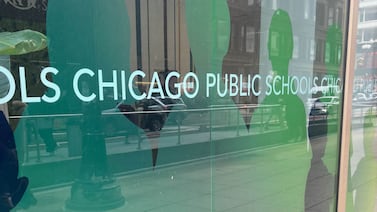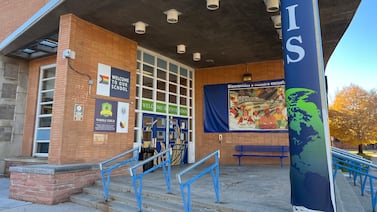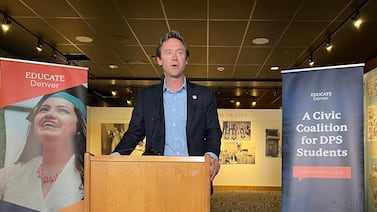Last week, Jennifer Coffey spent one of her lunch breaks at the Dollar Tree, loading her cart with inspirational posters and a large daily planner. The goal was to transform her dining room into a first-grade classroom, or at least recreate some of the fun on the walls.
With coronavirus cases rising in Indiana, Coffey is one of thousands of parents choosing not to send their children back to school, instead opting for the virtual learning provided by the school district. Other families were left to quickly change their plans after a handful of districts, including Indianapolis Public Schools and Washington Township, reversed their decisions to open in person.
As a result, many families are preparing to oversee their children’s education while juggling full-time jobs — whether that means leaving younger children in the care of their older siblings, enlisting a grandparent to help, hiring a college student to tutor, or banding together with other parents to create a “pandemic pod” to share e-learning and child care responsibilities.
The vast variation of what school will look like for students outside of classroom walls will further widen the gaps in educational equity, experts say, allowing some to speed along in their learning while others fall behind.
“To navigate this environment requires a lot of intensity in time resources that maybe lower-income parents don’t have,” said Breanca Merritt, the founding director of Indiana University’s Center for Research on Inclusion and Social Policy. “I think the assumption is that a parent will understand everything rolling up, and then be able to choose what’s best, but … you might not have any other options and you’re stuck.”
For Coffey, keeping her daughters at home from Avon Community Schools means she and her husband will have to designate shifts sitting with their 6-year-old, making up their work hours on weekends or early in the morning. While their older daughter, who is in sixth grade, will work in her room, they’re positioning the first grader in the dining room so they can hear if she needs help.
“It came down to regretting a potential health concern… or a potential death,” Coffey said. “We decided that, for us, despite the added stress and the potential frustrations — and maybe even inability to really function as a family — during e-learning times, that it was worth it to keep them home.”
Coffey recognizes that this is only possible because she and her husband both work from home and have understanding employers. They also have reliable internet and a 10-year-old laptop their first grader can use since the district doesn’t provide younger students devices.
Alicia Czyszczon, whose job in heating and plumbing is considered essential, can’t take time off to stay home with her school-aged daughter. She planned to send her back to school this fall, until Washington Township announced that wouldn’t be an option. Czyszczon then started looking for a “learning pod,” also dubbed a “pandemic pod,” made up of parents in a similar situation.
The idea for the pods gained momentum across the country as parents desperately sought more guidance and support for remote learning. Pods can be as simple as a few parents rotating child care, each responsible for one day a week. But in some affluent areas, parents have banded together to spend thousands to hire a private teacher or tutor — which is what Czyszczon was looking for, despite the potential cost.
“My kid’s education is the singular most important thing for her future right now,” Czyszczon said. “If I don’t put all of my resources into keeping her consistent, I have failed her as a parent.”
But, whether casual or led by a hired instructor, experts fear the pods will be stratified by income and potentially segregated.
“What happens for the kids who get left out?” said Merritt, a clinical assistant professor at IU. “Having something like a pod, obviously it’s good for the kids who can get in it. But the kids who can’t, their learning is going to look a lot different. ... And we know that those kids tend to be lower income. In some cases, lower income and students of color.”
It could be the latest manifestation of decades of segregation in schools, said L’Heureux Lewis-McCoy, an associate professor of sociology at New York University, largely driven by schools bending to meet the needs of white parents with influence or power. He said families should look for who is missing from the people they interact with, whether it be Black students or parents who are not college educated, and consider why. Then they should raise concerns with their district and ask for help creating equitable and accessible hubs.
“I think that if we start from a place of only thinking about our children, we actually miss the potential to contribute to the greater good,” Lewis-McCoy said. “In the U.S., when I hear people say, ‘I’ve got to do what’s best for my child,’ I agree, do what’s best for your child. But recognize that your individual choices have consequences for others.”
Some Indiana districts are stepping in to create options for families. IPS announced Thursday it will work with community partners to create a “student support network,” where students who need supervision and structure can do virtual work.
The district will also offer “learning hubs,” for students who are homeless or housing insecure or who receive physical and mental interventions.
Washington Township, which also will not offer in-person classes, partnered with At Your School to launch a virtual support program. Students in grades K-6 can complete their online classwork in grade-level groups of up to 15 under the supervision of program staff, who are trained in enrichment, said President and CEO Chrystal Struben. In the afternoon, the program will offer additional art and music projects.
Students will be required to wear masks and socially distance, Struben said. And each will undergo a screening, including a temperature check, every morning when they arrive.
But the program has its limitations. It’s already close to its 180-student capacity, doesn’t include transportation or lunch, and costs families $138 per week, with some federal voucher and financial assistance options for parents who qualify.
“I think parents are in unique situations and so for those who need that extra support for their student, I think that’s why this program is so important,” Struben said. “It’s great that parents are also stepping up and trying to combine efforts because it’s going to really take everyone in the community to make sure that their children are served.”
Czyszczon ultimately enrolled her child in AYS for the fall, unable to find a pandemic pod in the area. She said she was relieved to see the district created the option, because she didn’t know what to do.
But she’s still concerned that her daughter will lose ground during a critical year by not working face to face with a teacher daily. If she sees her fall behind, her daughter may have to live more than an hour away with her grandparents, who could monitor her more closely.
“I would literally stop at nothing to make sure my kid gets an education,” she said.







